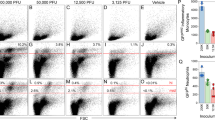Abstract
Seizure disorders are often associated with infectious etiologies. Infection, via the intracerebral (i.c.) route, of C57BL/6J mice with the Daniels (DA) strain of Theiler’s murine encephalomyelitis virus (TMEV) results in approximately 50% of the mice developing acute behavioral seizures. TMEV-DA is the wild-type strain of the virus that replicates within the parenchyma of the brain. A variant of TMEV-DA, TMEV-H101, does not replicate within the parenchyma of the brain. However, infection with TMEV-H101 via the i.c. route still results in approximately 40% of the mice developing acute behavioral seizures. Infiltrating macrophages producing interleukin-6 (IL-6) have been implicated in the induction of acute seizures following TMEV-DA infection. We examined macrophage infiltration and microglial activation within the brain and cytokine levels in the periphery in mice infected with TMEV-DA or TMEV-H101 and assessed the effects of the addition of recombinant IL-6 to the periphery in wild-type and IL-6 knockout mice infected with TMEV-DA. We found that pathologic levels of IL-6 in the periphery may play a role in the development of seizures when viral replication within the brain is limited. Examination of the role played by the peripheral immune system in the development of seizures/epilepsy in the TMEV-induced seizure model, the first viral infection driven model for epilepsy, could lead to the elucidation of novel therapeutics.




Similar content being viewed by others
References
Benkovic SA, O'Callaghan JP, Miller DB (2004) Sensitive indicators of injury reveal hippocampal damage in C57BL/6J mice treated with kainic acid in the absence of tonic-clonic seizures. Brain Res 1024:59–76
Campbell IL, Abraham CR, Masliah E, Kemper P, Inglis JD, Oldstone MB, Mucke L (1993) Neurologic disease induced in transgenic mice by cerebral overexpression of interleukin 6. Proc Natl Acad Sci U S A 90:10061–10065
Cusick MF, Libbey JE, Patel DC, Doty DJ, Fujinami RS (2013) Infiltrating macrophages are key to the development of seizures following virus infection. J Virol 87:1849–1860
Cusick MF, Libbey JE, Doty DJ, Fujinami RS (2014) DA virus mutant H101 has altered CNS pathogenesis and causes immunosuppression. J Neuroimmunol 277:118–126
Dal Canto MC, Lipton HL (1982) Ultrastructural immunohistochemical localization of virus in acute and chronic demyelinating Theiler’s virus infection. Am J Pathol 106:20–29
Ford AL, Goodsall AL, Hickey WF, Sedgwick JD (1995) Normal adult ramified microglia separated from other central nervous system macrophages by flow cytometric sorting. Phenotypic differences defined and direct ex vivo antigen presentation to myelin basic protein-reactive CD4+ T cells compared. J Immunol 154:4309–4321
Howe CL, LaFrance-Corey RG, Sundsbak RS, LaFrance SJ (2012a) Inflammatory monocytes damage the hippocampus during acute picornavirus infection of the brain. J Neuroinflammation 9:50
Howe CL, LaFrance-Corey RG, Sundsbak RS, Sauer BM, LaFrance SJ, Buenz EJ, Schmalstieg WF (2012b) Hippocampal protection in mice with an attenuated inflammatory monocyte response to acute CNS picornavirus infection. Sci Rep 2:545
Kirkman NJ, Libbey JE, Wilcox KS, White HS, Fujinami RS (2010) Innate but not adaptive immune responses contribute to behavioral seizures following viral infection. Epilepsia 51:454–464
Libbey JE, Fujinami RS (2011) Neurotropic viral infections leading to epilepsy: focus on Theiler’s murine encephalomyelitis virus. Future Virol 6:1339–1350
Libbey JE, Kennett NJ, Wilcox KS, White HS, Fujinami RS (2011a) Interleukin-6, produced by resident cells of the central nervous system and infiltrating cells, contributes to the development of seizures following viral infection. J Virol 85:6913–6922
Libbey JE, Kennett NJ, Wilcox KS, White HS, Fujinami RS (2011b) Lack of correlation of central nervous system inflammation and neuropathology with the development of seizures following acute virus infection. J Virol 85:8149–8157
Lipton HL (1975) Theiler’s virus infection in mice: an unusual biphasic disease process leading to demyelination. Infect Immun 11:1147–1155
Nieuwenhuys R, Voogd J, van Huijzen C (2008) Blood supply, meninges and cerebrospinal fluid circulation. In: The human central nervous system, 4th edn. Springer, New York, pp 95–135
Racine RJ (1972) Modification of seizure activity by electrical stimulation. II. Motor seizure. Electroencephalogr Clin Neurophysiol 32:281–294
Sedgwick JD, Schwender S, Imrich H, Dorries R, Butcher GW, ter Meulen V (1991) Isolation and direct characterization of resident microglial cells from the normal and inflamed central nervous system. Proc Natl Acad Sci U S A 88:7438–7442
Theiler M (1937) Spontaneous encephalomyelitis of mice, a new virus disease. J Exp Med 65:705–719
Theiler M, Gard S (1940) Encephalomyelitis of mice : I. Characteristics and pathogenesis of the virus. J Exp Med 72:49–67
Tsunoda I, McCright IJ, Kuang LQ, Zurbriggen A, Fujinami RS (1997) Hydrocephalus in mice infected with a Theiler’s murine encephalomyelitis virus variant. J Neuropathol Exp Neurol 56:1302–1313
Zurbriggen A, Thomas C, Yamada M, Roos RP, Fujinami RS (1991) Direct evidence of a role for amino acid 101 of VP-1 in central nervous system disease in Theiler’s murine encephalomyelitis virus infection. J Virol 65:1929–1937
Acknowledgments
We would like to thank Jordan T. Sim, BA, and Mitchell A. Wilson for excellent technical assistance; Karen S. Wilcox, PhD, and F. Lynn Sonderegger, PhD, for helpful discussions; and Daniel J. Harper for the outstanding preparation of the manuscript.
This work was supported by NIH T32AI055434 (M.F.C.), 1R01NS065714 (R.S.F.), and the Emma Mary Deland Foundation (R.S.F.). The funders had no role in study design, data collection and interpretation, or the decision to submit the work for publication.
Author information
Authors and Affiliations
Corresponding author
Ethics declarations
Conflict of interest
The authors declare that they have no conflict of interest.
Rights and permissions
About this article
Cite this article
Cusick, M.F., Libbey, J.E., Doty, D.J. et al. The role of peripheral interleukin-6 in the development of acute seizures following virus encephalitis. J. Neurovirol. 23, 696–703 (2017). https://doi.org/10.1007/s13365-017-0554-8
Received:
Revised:
Accepted:
Published:
Issue Date:
DOI: https://doi.org/10.1007/s13365-017-0554-8




